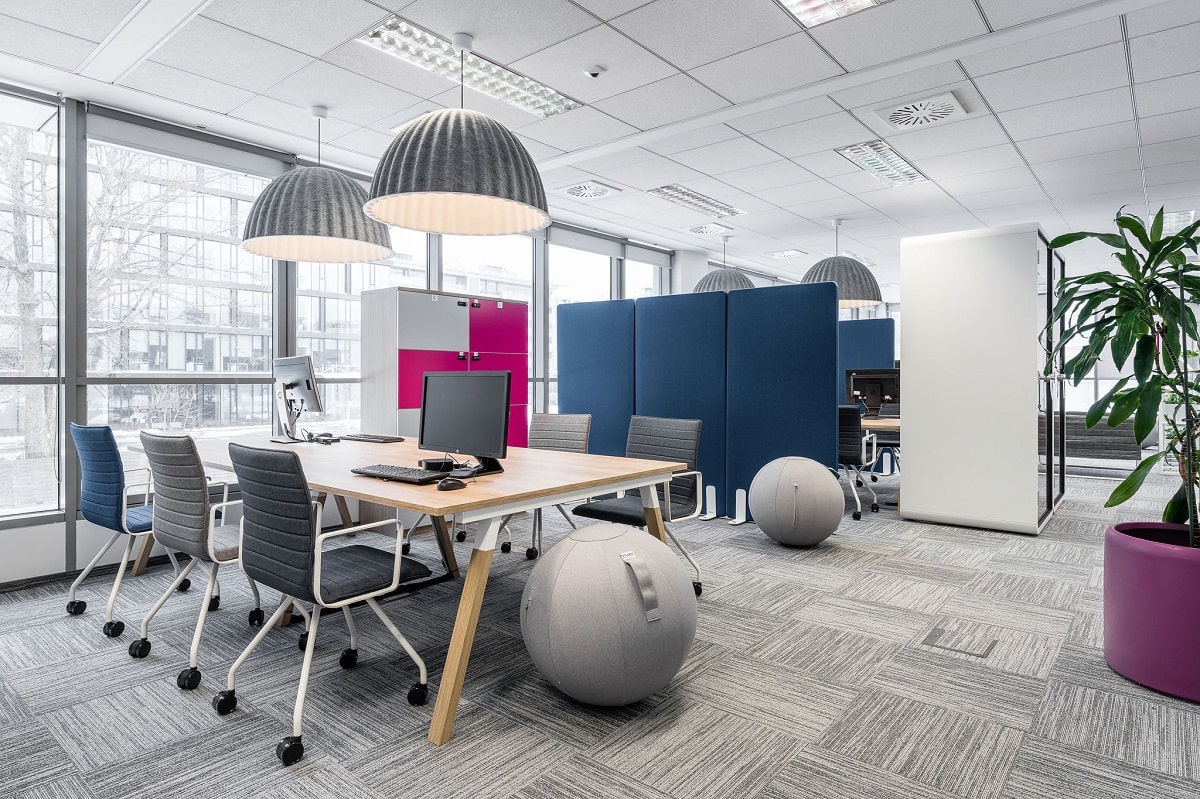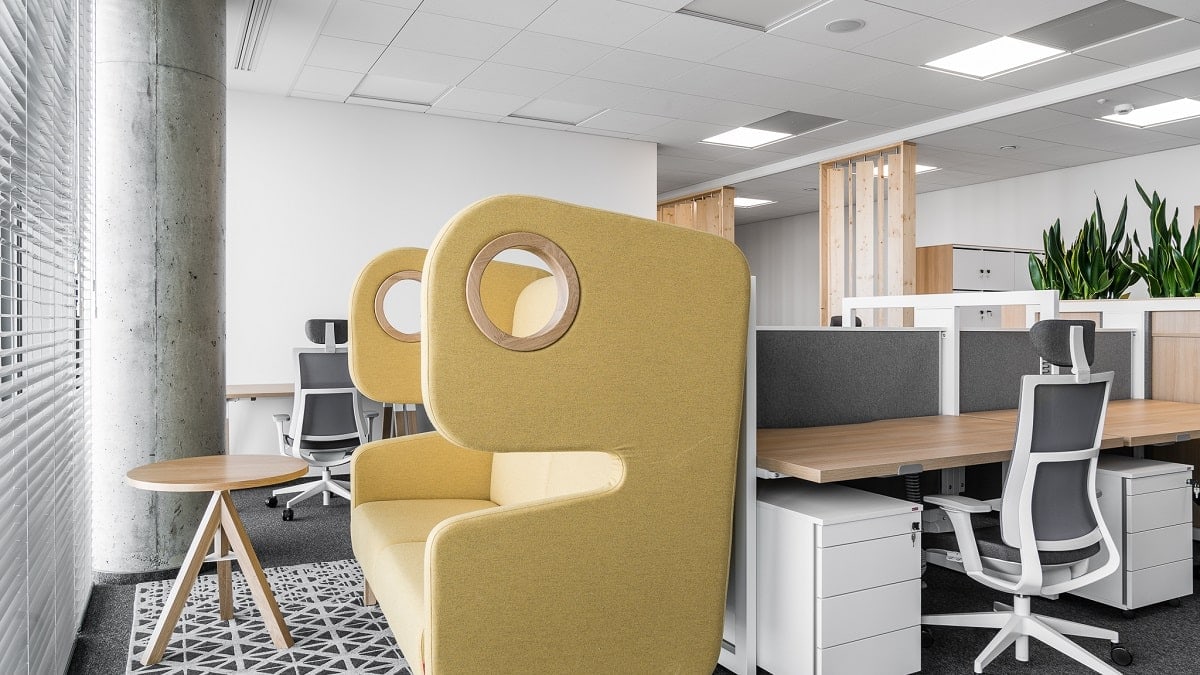What office design elements support employee efficiency?

Salary, atmosphere, development opportunities, benefits – until recently, these elements were considered decisive for the successful recruitment of new employees. However, new generations entering the labour market are paying increasing attention to the environment of the workplace. A well-designed office significantly influences employee efficiency, creativity and satisfaction and attracts talents. Companies recognising this trend are investing in décor that is staff friendly. Find out what office design elements contribute to visual appeal and can encourage action and growth.
The impact of office design on work comfort. The creative worker is moving away from the desk
The impact of office design on work comfort is undeniable, especially when it comes to efficiency and employee satisfaction. A properly designed workplace with ergonomic principles in mind brings tangible benefits for the team and the employer. Elements such as suitable chairs or adjustable desks in open-plan spaces help to improve working comfort, reducing the risk of discomfort associated with prolonged sitting.
At the same time, it should be remembered that today’s employees perform such a wide variety of tasks that it is increasingly better for them to perform them away from their desks. They are more willing to choose a space that encourages a free flow of ideas and inspiration. Therefore, in recent years, more attention has been paid to creative office design that prioritises a variety of work zones (individual, collaboration and regeneration).
It is also worth considering the need for flexibility and the ability to easily transform the space to accommodate the changing needs of the team. Introducing relaxation zones into the office, such as spaces with soft seating, where employees can relax during breaks or work in a more casual atmosphere, promotes a balance between work and rest.
Can office design elements affect employee productivity?
Employers are well aware that the office is the business card of the company and its design cannot be casual. However, in addition to influencing the opinions of contractors, the arrangement of the space can also affect employees. When we are in different rooms, their design is important for our well-being and comfort. The same is true when employees come into the office – the more welcoming and tailored the space, the better it is for their concentration and efficiency.
Modular and multifunctional furniture
In order to perform at the highest level, employees need the right space in which to operate. Arrangements whose main purpose was to place multiple desks next to each other are a thing of the past. This office layout makes it difficult for employees to concentrate and lacks privacy and tranquility. The right space arrangement and modular office furniture, will ensure that you can perform your duties in a way that promotes creativity and efficiency. Thanks to their flexibility and their ability to be configured in different layouts, these solutions guarantee a more efficient use of space in hybrid offices.
According to the expert
Modular solutions (such as the Ligo cube system) in offices based on the open-space concept are indispensable for creating work, meeting and relaxation zones. Collaboration between employees is key to achieving good results, while multifunctional furniture facilitates an organised space that encourages communication and the exchange of ideas. Introducing modern modular solutions into the office is therefore an investment in long-term results and employee satisfaction
– says Eliza Donek, Product Manager at Mikomax.
More separate zones in the office
Another element that can affect employee productivity is more dedicated zones in the office. These spaces can include communal areas, quiet zones, areas for individual work and meeting rooms for video conferencing or presentations. Such a division allows employees, whose duties have long since ceased to consist merely of completing file after file, to choose where to work depending on the type of task at hand. Zones demarcated in a simple way, using Soniq mobile acoustic walls, can also promote better communication between team members, manage noise and reduce disruption.
Do you want your office to attract new employees and drive efficiency?
Check out our range of modern office furniture
Greenery and natural light
Plants bring an element of nature into office spaces, purifying the air, reducing carbon dioxide levels and increasing humidity. Nature-inspired offices are no longer uncommon and the trend is steadily gaining ground, as greenery reduces stress, improves well-being and allows for a healthy working environment. Introducing plants into the office, and ensuring access to natural light, can help to increase staff productivity and creativity. It is worth noting that prolonged exposure to artificial lighting leads to visual fatigue, headaches and reduced concentration.
According to the expert
Incorporating elements such as multifunctional modular furniture and more separate zones, as well as greenery and natural light into the office design significantly affects employee productivity. Properly designed and arranged company spaces are not only conducive to better concentration and comfort at work, but also build an atmosphere of cooperation and commitment. Investing in these aspects of office design benefits both the employer, who gains a more effective team, and the employees, who enjoy a greater sense of well-being and job satisfaction
– says Eliza Donek, Product Manager at Mikomax.
Design thinking in office design – how to get employees’ attention
Design thinking is an approach to problem solving that focuses on the real needs and motivations of the audience. This method assumes that the office design process should start by considering the needs of the space’s users. It is necessary to understand the organisation of work in the company by analysing typical working days and the most frequently used tools. The various ideas and solutions should then be verified through testing.
A good example of this would be the ergonomic desks with height-adjustable tops, which were developed after a problem was diagnosed with a decrease in efficiency and comfort due to the sedentary working mode. Through the concept of design thinking, the office arrangement becomes more flexible, functional and customised. This translates into increased work efficiency and satisfaction with the space used.
Emotions and needs of employees kept in sight
When designing an office according to the design thinking method, it is important to remember that the employee who will use the space should be at the centre of the process. By using a method of observation, interviews and analysis, facility managers and project managers are able to understand what is critical to the team and what aspects of the working environment affect their effectiveness and well-being. In this way, the office becomes a space that is not only aesthetically appealing, but also functional, comfortable and tailored to the needs of each employee.
What colours and materials should you choose to make your office more attractive?
When choosing wall colours, upholstered furniture or accessories, it is worth opting for those that promote concentration, creativity and a good atmosphere. All shades of blue, green, grey, as well as yellows, beige or pastel colours will work well. It is wrong to use the same colour in all office spaces, as monotony is bad for employee motivation. The colour of the walls and accessories should take into account the purpose of the room. Boredom can be broken by playing gently with shades or by choosing furniture with an intriguing shape, such as the Packman collection of armchairs and sofas, which look like a character from a well-known computer game.
When it comes to materials, it is worth investing in strong, durable and environmentally friendly raw materials, such as wood, stainless steel or glass. A carefully selected palette of colours, materials and furniture will make the office more attractive and functional.

The importance of detail – what elements of office design affect aesthetics?
Details are crucial in creating the aesthetics of an office – they influence the atmosphere and the perception of the room by employees and clients. Choosing the right design elements can make the office more welcoming and inspire employees to work more efficiently. Tree-like acoustic walls are one of the solutions that combine functionality with aesthetics. They allow for noise reduction, which promotes better concentration, while introducing natural themes into the office space. They make the interior more cosy and inspiring.
Lighting influences mood and comfort, so it is worth investing in a variety of light sources, such as standing and desk lamps or ceiling lights. Furniture should be ergonomic, aesthetically pleasing and tailored to the needs of the users. In turn, decorations such as paintings, prints or rugs will add character and uniqueness to the space.
Want to make your office more staff-friendly?
Take advantage of modular furniture and increase the number of separate zones
